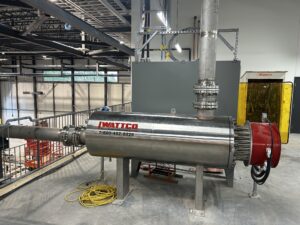Industrial Uses of Inline Water Heaters
Last updated on June 22nd, 2023 at 02:21 pm
Inline water heaters are unique because they allow water and other fluids to pass directly through them. That makes them highly effective for certain industrial processes, especially cleaning, comfort heating, and oil and caustic solutions. Of course, not all inline water heaters are built the same. This post will explain how inline heaters work and what applications they’re best suited for.
Inline water heater function
 Inline heaters work by instantly heating fluids that pass through them. An electric power source generates heat, which is transferred to the fluid passing through the heater. Once the fluid exits the heater, it goes toward its target vessel (and application) and does not recirculate into the heater. Instead, a pump unit transports the fluid into a circulation system.
Inline heaters work by instantly heating fluids that pass through them. An electric power source generates heat, which is transferred to the fluid passing through the heater. Once the fluid exits the heater, it goes toward its target vessel (and application) and does not recirculate into the heater. Instead, a pump unit transports the fluid into a circulation system.
The fluid circulates and gets reheated in a closed loop circuit around an immersion heater until it reaches a desired temperature. Inline heaters are designed to generate heat for immediate use, not for high temperatures, in a closed system.
Fuel sources for inline water heaters vary considerably. Fossil-fuel-based sources, such as gasoline, diesel, and natural gas have been staple sources of fuel for inline water heaters for years. However, greener alternatives, such as electric and solar heaters have become more commonplace.
Common features of inline heaters
To maximize their heating efficiency, inline heaters may come with construction modifications to help sustain desired temperatures. One key feature is a corrosion-resistant metallic casing that serves as an insulator, so there’s no heat loss during the heating process.
Customization is available for inline heaters, too, especially for wattages, because manipulating watt output allows operators to exert more control over temperatures generated by the heater. This is ideal for fluids where maintaining viscosity is vital. To add wattage control, inline heaters can be fitted with temperature controls to adjust temperature output.
Depending on the industrial application, inline heaters carry many advantages.
Benefits of inline heaters
- Fast response and uniform distribution of heat
- Supplies maximum dielectric strength
- Reduces heat loss (which maximizes heating efficiency)
- Offers greater wattage potential in smaller bundles
- Supports specialty-purpose terminals (explosion-proof, moisture-resistant, weather-resistant etc.)
- Easy to install, mount, and clean
Ultimately, the true potential of an inline heater comes from the customizations added to it to support an application effectively.
Industrial uses of inline water heaters
The potential for inline water heaters is expansive and often underappreciated. They can be used for small-scale comfort heating operations to more heavily sophisticated ones involving chemical processing. Virtually any application that needs immediate fluid heating can use an inline heater, and these devices aren’t limited to water use (despite their name).
Examples of inline water heaters in action
- Water heating applications: The most common use of inline heaters are for water applications. They include the likes of water purification, clean water heating, and process water heating.
- Heating oil applications: Inline “water” heaters are also a staple in the oil heating world and are ideal for both light and heavy oil applications. Because of their heat and thermal efficiency, inline heaters help maintain the required viscosity of oil for most applications.
- Annealing and tempering: Treating metals to adhere to a specific form requires significant heating. Water heating is part of the process, which inline water heaters can facilitate.
- Steam heating: Some industrial settings, such as commercial kitchens and nuclear power plants, rely on steam heating, which requires high water temperatures. Inline water heaters are often used to sustain these temperatures.
Wattco inline water heaters
Ultimately, the use potential for an inline water heater depends on its intended application. As we stated above, inline water heaters serve a wide range of industries and assuming your application has been indicated, you can rely on one for your operations. Of course, there are exceptions that may contraindicate the use of an inline heater or allow one for your operation.
At Wattco, we offer pre-built and custom-made inline water heaters for various industries. We can adjust a heater’s wattage for particularly complex applications and add features, such as temperature controls. We can also adjust heating elements, namely, the materials used in the sheath. Providing your application requires rapid fluid heating, we can find or create a solution that fits your needs.
Get a quote for your inline water heater today. Our representatives will help you find the exact setup needed for your industrial needs.
